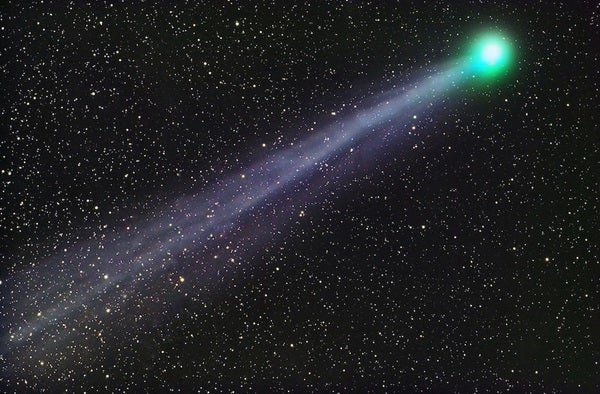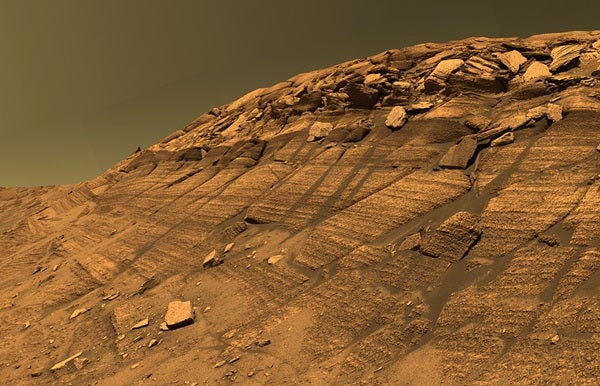This week offers a good opportunity for binocular users to track down the northern sky’s brightest globular cluster. M5, whose 100,000 stars glow at a combined magnitude of 5.7, lies in the southwestern corner of the constellation Serpens the Serpent. You can locate it just 0.4° north-northwest of the 5th-magnitude star 5 Serpentis. Binoculars show the cluster as a hazy ball of light punctuated by a bright core.
Saturday, June 23
The waxing gibbous Moon passes near Jupiter tonight. From North America, the two were closest this afternoon (when they were below the horizon), though they remain within 5° of each other after darkness falls. Despite Luna’s brilliance dominating the scene, you should have little trouble picking out the magnitude –2.4 planet to its lower right. The best time to observe Jupiter through a telescope is when the Moon doesn’t lie so close. This week, the gas giant spans 42″ and displays a wealth of detail in its cloud tops.
Sunday, June 24
Observers of the outer solar system get their first good views of Uranus before dawn in late June. The best time to look for it is shortly before twilight begins around 3:30 a.m. local daylight time. Uranus then lies 15° above the eastern horizon among the background stars of southwestern Aries the Ram. This morning, use binoculars to find the magnitude 5.9 planet 4° northeast of the 4th-magnitude star Omicron (ο) Piscium. A telescope reveals Uranus’ blue-green disk, which spans 3.5″.
Skygazers can catch a peek of Mercury in this week’s early evening sky. The innermost planet stands 9° high in the west-northwest a half-hour after sunset tonight, and it will gain another degree of altitude by the weekend. Although Mercury glows brightly this evening, at magnitude –0.4, you might need binoculars to spot it initially against the twilight glow. Binoculars also should reveal the 1st-magnitude star Pollux, which stands 5° north of the planet tonight. Through a telescope, Mercury shows a disk that spans 6.1″ and appears 70 percent lit.
Tuesday, June 26
Look high in the northwest after darkness falls, and you’ll be greeted by the familiar sight of the Big Dipper. The Dipper is the most conspicuous asterism — a recognizable pattern of stars that doesn’t form a complete constellation shape — in the entire sky. It forms the body and tail of Ursa Major the Great Bear. Use the Pointers, the two stars at the end of the Dipper’s bowl, to find Polaris, which lies due north for everyone north of the equator. Polaris marks the end of the Little Dipper’s handle. On June evenings, the relatively faint stars of this dipper arc directly above Polaris.
Wednesday, June 27
Saturn lies opposite the Sun in our sky today, reaching its peak visibility for 2018. The ringed world appears low in the southeast as darkness falls and climbs higher as the evening wears on. It stands about one-third of the way to the zenith in the southern sky around 1 a.m. local daylight time. If you need help finding Saturn, tonight’s Full Moon points the way. Our satellite lies within 2° of the planet all night. (The Moon is officially Full at 12:53 a.m. EDT tomorrow morning.) Saturn shines at magnitude 0.0 and stands out well on any other night this week when the Moon isn’t so close. Both objects lie among the background stars of northern Sagittarius. When viewed through a telescope this week, the planet shows an 18″-diameter disk surrounded by a dramatic ring system that spans 42″ and tilts 26° to our line of sight.
Thursday, June 28
Mars remains a stunning sight all week. The Red Planet reaches its stationary point today, which means that its eastward motion relative to the background stars of Capricornus comes to a halt and it begins moving westward. Mars rises around 11 p.m. local daylight time and climbs highest in the south just before morning twilight commences. The planet shines at magnitude –2.1, making the third-brightest point of light in the night sky after Venus and Jupiter. If you point a telescope toward Mars, you’ll see its 21″-diameter disk and perhaps some subtle surface features — though many of these likely will be obscured by the planet’s major ongoing dust storm.
Venus dominates the western sky after sunset. The dazzling object shines at magnitude –4.1 among the background stars of western Leo, having crossed the border from Cancer earlier in the day. The planet appears 15° high an hour after sundown and sets around 11 p.m. local daylight time. When viewed through a telescope, Venus appears 16″ across and 70 percent lit.
The Moon reaches apogee, the farthest point in its orbit around Earth, at 10:43 p.m. EDT. It then lies 252,315 miles (406,061 kilometers) from Earth’s center.
Saturday, June 30
The waning gibbous Moon rises in the east-southeast just as the last vestiges of twilight fade away. About 15 minutes later, ruddy Mars joins our satellite. The two stand about 5° apart as they cross the sky tonight.
For people who live near 30° north latitude, today marks the latest sunset of the year. Although Earth’s summer solstice and the Northern Hemisphere’s longest day occurred more than a week ago (on the 21st), latest sunset happens several days after and earliest sunrise several days before. The specific dates depend on your latitude, however — latest sunset at 40° north took place June 27. In general, latest sunset occurs closer to the solstice the farther north you live.
Sunday, July 1
Now that the Moon is exiting the evening sky, this is a good opportunity for binocular users to track down one of summer’s finest open star clusters. NGC 6231 lies in the tail of Scorpius the Scorpion, just 0.5° north of the double star Zeta (ζ) Scorpii (which is another fine binocular sight). NGC 6231 shines at magnitude 2.6 and packs more than 100 stars into a region about half the width of the Full Moon. This part of Scorpius lies nearly due south after darkness falls, though it doesn’t climb high from mid-northern latitudes.












